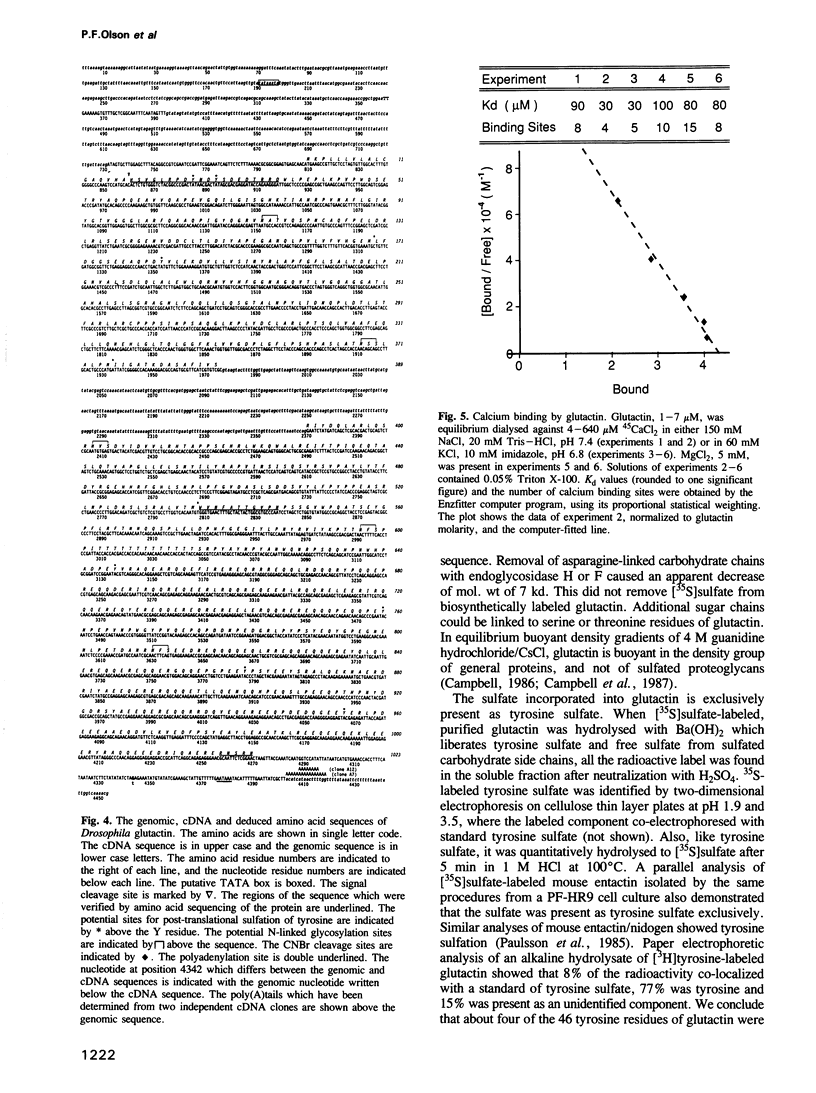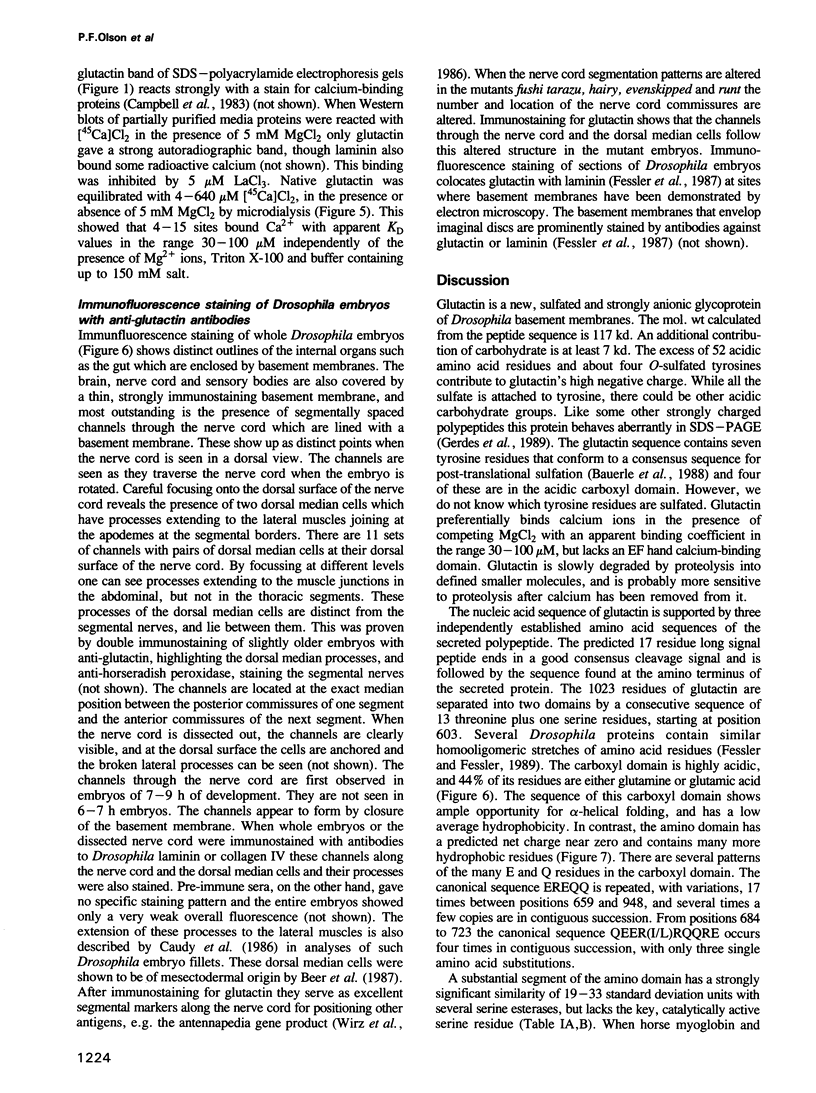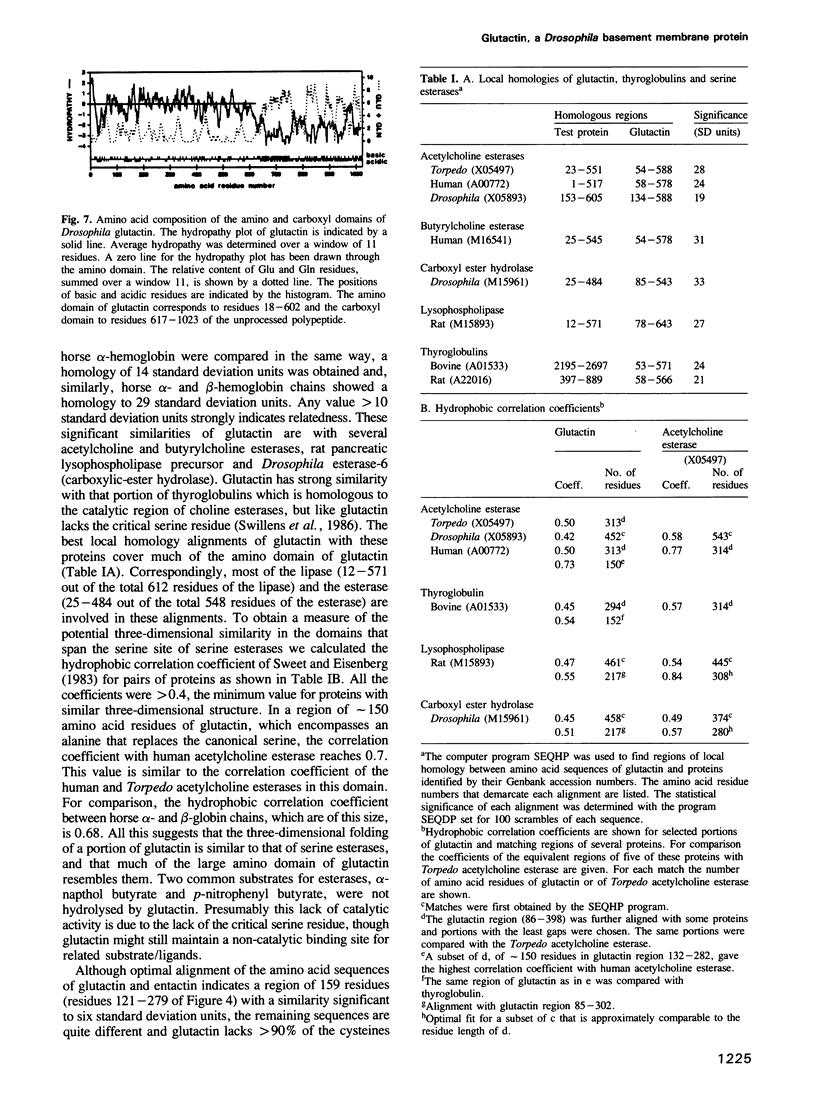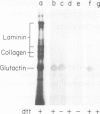Abstract
Glutactin, a new acidic sulfated glycoprotein, was isolated from Drosophila Kc cell culture media. Immunofluorescence microscopy located it to embryonic basement membranes, particularly to the sequentially invaginated envelope of the central nervous system, muscle apodemes and dorsal median cell processes. Its chromosome locus is 29D. The nucleic acid sequence coding for the 1023 residue long polypeptide contains one intron and was confirmed by partial amino acid sequencing. Glutactin has a signal peptide and an amino domain of greater than 500 residues that strongly resembles acetylcholine esterases and other serine esterases, but lacks the catalytically critical serine residue. The amino and carboxyl domains of glutactin are separated by 13 contiguous threonine residues. Glutamine and glutamic acid make up 44% of glutactin's very acidic carboxyl domain. Glutactin preferentially binds Ca2+ in the presence of excess Mg2+ and four of its tyrosines are O-sulfated. Several similarities with mammalian entactin caused our previous, preliminary mention of glutactin as a putative Drosophila entactin, but sequence comparison now shows them to be different proteins.
Full text
PDF








Images in this article
Selected References
These references are in PubMed. This may not be the complete list of references from this article.
- Baeuerle P. A., Lottspeich F., Huttner W. B. Purification of yolk protein 2 of Drosophila melanogaster and identification of its site of tyrosine sulfation. J Biol Chem. 1988 Oct 15;263(29):14925–14929. [PubMed] [Google Scholar]
- Blumberg B., MacKrell A. J., Fessler J. H. Drosophila basement membrane procollagen alpha 1(IV). II. Complete cDNA sequence, genomic structure, and general implications for supramolecular assemblies. J Biol Chem. 1988 Dec 5;263(34):18328–18337. [PubMed] [Google Scholar]
- Blumberg B., MacKrell A. J., Olson P. F., Kurkinen M., Monson J. M., Natzle J. E., Fessler J. H. Basement membrane procollagen IV and its specialized carboxyl domain are conserved in Drosophila, mouse, and human. J Biol Chem. 1987 May 5;262(13):5947–5950. [PubMed] [Google Scholar]
- Brutlag D., Appels R., Dennis E. S., Peacock W. J. Highly repeated DNA in Drosophila melanogaster. J Mol Biol. 1977 May 5;112(1):31–47. doi: 10.1016/s0022-2836(77)80154-x. [DOI] [PubMed] [Google Scholar]
- Campbell A. G., Fessler L. I., Salo T., Fessler J. H. Papilin: a Drosophila proteoglycan-like sulfated glycoprotein from basement membranes. J Biol Chem. 1987 Dec 25;262(36):17605–17612. [PubMed] [Google Scholar]
- Campbell K. P., MacLennan D. H., Jorgensen A. O. Staining of the Ca2+-binding proteins, calsequestrin, calmodulin, troponin C, and S-100, with the cationic carbocyanine dye "Stains-all". J Biol Chem. 1983 Sep 25;258(18):11267–11273. [PubMed] [Google Scholar]
- Clegg D. O., Helder J. C., Hann B. C., Hall D. E., Reichardt L. F. Amino acid sequence and distribution of mRNA encoding a major skeletal muscle laminin binding protein: an extracellular matrix-associated protein with an unusual COOH-terminal polyaspartate domain. J Cell Biol. 1988 Aug;107(2):699–705. doi: 10.1083/jcb.107.2.699. [DOI] [PMC free article] [PubMed] [Google Scholar]
- Durkin M. E., Chakravarti S., Bartos B. B., Liu S. H., Friedman R. L., Chung A. E. Amino acid sequence and domain structure of entactin. Homology with epidermal growth factor precursor and low density lipoprotein receptor. J Cell Biol. 1988 Dec;107(6 Pt 2):2749–2756. doi: 10.1083/jcb.107.6.2749. [DOI] [PMC free article] [PubMed] [Google Scholar]
- Eley M. H., Burns P. C., Kannapell C. C., Campbell P. S. Cetyltrimethylammonium bromide polyacrylamide gel electrophoresis: estimation of protein subunit molecular weights using cationic detergents. Anal Biochem. 1979 Jan 15;92(2):411–419. doi: 10.1016/0003-2697(79)90679-1. [DOI] [PubMed] [Google Scholar]
- Fessler J. H., Fessler L. I. Drosophila extracellular matrix. Annu Rev Cell Biol. 1989;5:309–339. doi: 10.1146/annurev.cb.05.110189.001521. [DOI] [PubMed] [Google Scholar]
- Fessler L. I., Brosh S., Chapin S., Fessler J. H. Tyrosine sulfation in precursors of collagen V. J Biol Chem. 1986 Apr 15;261(11):5034–5040. [PubMed] [Google Scholar]
- Fessler L. I., Campbell A. G., Duncan K. G., Fessler J. H. Drosophila laminin: characterization and localization. J Cell Biol. 1987 Nov;105(5):2383–2391. doi: 10.1083/jcb.105.5.2383. [DOI] [PMC free article] [PubMed] [Google Scholar]
- Fessler L. I., Fessler J. H. Protein assembly of procollagen and effects of hydroxylation. J Biol Chem. 1974 Dec 10;249(23):7637–7646. [PubMed] [Google Scholar]
- Gerdes H. H., Rosa P., Phillips E., Baeuerle P. A., Frank R., Argos P., Huttner W. B. The primary structure of human secretogranin II, a widespread tyrosine-sulfated secretory granule protein that exhibits low pH- and calcium-induced aggregation. J Biol Chem. 1989 Jul 15;264(20):12009–12015. [PubMed] [Google Scholar]
- Hogan B. L., Taylor A., Kurkinen M., Couchman J. R. Synthesis and localization of two sulphated glycoproteins associated with basement membranes and the extracellular matrix. J Cell Biol. 1982 Oct;95(1):197–204. doi: 10.1083/jcb.95.1.197. [DOI] [PMC free article] [PubMed] [Google Scholar]
- Horwitz A., Duggan K., Greggs R., Decker C., Buck C. The cell substrate attachment (CSAT) antigen has properties of a receptor for laminin and fibronectin. J Cell Biol. 1985 Dec;101(6):2134–2144. doi: 10.1083/jcb.101.6.2134. [DOI] [PMC free article] [PubMed] [Google Scholar]
- Hunkapiller M. W., Hewick R. M., Dreyer W. J., Hood L. E. High-sensitivity sequencing with a gas-phase sequenator. Methods Enzymol. 1983;91:399–413. doi: 10.1016/s0076-6879(83)91038-8. [DOI] [PubMed] [Google Scholar]
- Huttner W. B. Determination and occurrence of tyrosine O-sulfate in proteins. Methods Enzymol. 1984;107:200–223. doi: 10.1016/0076-6879(84)07013-0. [DOI] [PubMed] [Google Scholar]
- Keller E. B., Noon W. A. Intron splicing: a conserved internal signal in introns of Drosophila pre-mRNAs. Nucleic Acids Res. 1985 Jul 11;13(13):4971–4981. doi: 10.1093/nar/13.13.4971. [DOI] [PMC free article] [PubMed] [Google Scholar]
- Kozak M. Point mutations define a sequence flanking the AUG initiator codon that modulates translation by eukaryotic ribosomes. Cell. 1986 Jan 31;44(2):283–292. doi: 10.1016/0092-8674(86)90762-2. [DOI] [PubMed] [Google Scholar]
- Langer-Safer P. R., Levine M., Ward D. C. Immunological method for mapping genes on Drosophila polytene chromosomes. Proc Natl Acad Sci U S A. 1982 Jul;79(14):4381–4385. doi: 10.1073/pnas.79.14.4381. [DOI] [PMC free article] [PubMed] [Google Scholar]
- Mann K., Deutzmann R., Aumailley M., Timpl R., Raimondi L., Yamada Y., Pan T. C., Conway D., Chu M. L. Amino acid sequence of mouse nidogen, a multidomain basement membrane protein with binding activity for laminin, collagen IV and cells. EMBO J. 1989 Jan;8(1):65–72. doi: 10.1002/j.1460-2075.1989.tb03349.x. [DOI] [PMC free article] [PubMed] [Google Scholar]
- Maruyama K., Nonomura Y. High molecular weight calcium binding protein in the microsome of scallop striated muscle. J Biochem. 1984 Sep;96(3):859–870. doi: 10.1093/oxfordjournals.jbchem.a134904. [DOI] [PubMed] [Google Scholar]
- Mount S. M. A catalogue of splice junction sequences. Nucleic Acids Res. 1982 Jan 22;10(2):459–472. doi: 10.1093/nar/10.2.459. [DOI] [PMC free article] [PubMed] [Google Scholar]
- Olsen D. R., Nagayoshi T., Fazio M., Mattei M. G., Passage E., Weil D., Timpl R., Chu M. L., Uitto J. Human nidogen: cDNA cloning, cellular expression, and mapping of the gene to chromosome Iq43. Am J Hum Genet. 1989 Jun;44(6):876–885. [PMC free article] [PubMed] [Google Scholar]
- Paulsson M., Dziadek M., Suchanek C., Huttner W. B., Timpl R. Nature of sulphated macromolecules in mouse Reichert's membrane. Evidence for tyrosine O-sulphate in basement-membrane proteins. Biochem J. 1985 Nov 1;231(3):571–579. doi: 10.1042/bj2310571. [DOI] [PMC free article] [PubMed] [Google Scholar]
- Perlman D., Halvorson H. O. A putative signal peptidase recognition site and sequence in eukaryotic and prokaryotic signal peptides. J Mol Biol. 1983 Jun 25;167(2):391–409. doi: 10.1016/s0022-2836(83)80341-6. [DOI] [PubMed] [Google Scholar]
- Proudfoot N. J., Brownlee G. G. 3' non-coding region sequences in eukaryotic messenger RNA. Nature. 1976 Sep 16;263(5574):211–214. doi: 10.1038/263211a0. [DOI] [PubMed] [Google Scholar]
- Sweet R. M., Eisenberg D. Correlation of sequence hydrophobicities measures similarity in three-dimensional protein structure. J Mol Biol. 1983 Dec 25;171(4):479–488. doi: 10.1016/0022-2836(83)90041-4. [DOI] [PubMed] [Google Scholar]
- Swillens S., Ludgate M., Mercken L., Dumont J. E., Vassart G. Analysis of sequence and structure homologies between thyroglobulin and acetylcholinesterase: possible functional and clinical significance. Biochem Biophys Res Commun. 1986 May 29;137(1):142–148. doi: 10.1016/0006-291x(86)91187-3. [DOI] [PubMed] [Google Scholar]
- Wirz J., Fessler L. I., Gehring W. J. Localization of the Antennapedia protein in Drosophila embryos and imaginal discs. EMBO J. 1986 Dec 1;5(12):3327–3334. doi: 10.1002/j.1460-2075.1986.tb04647.x. [DOI] [PMC free article] [PubMed] [Google Scholar]





